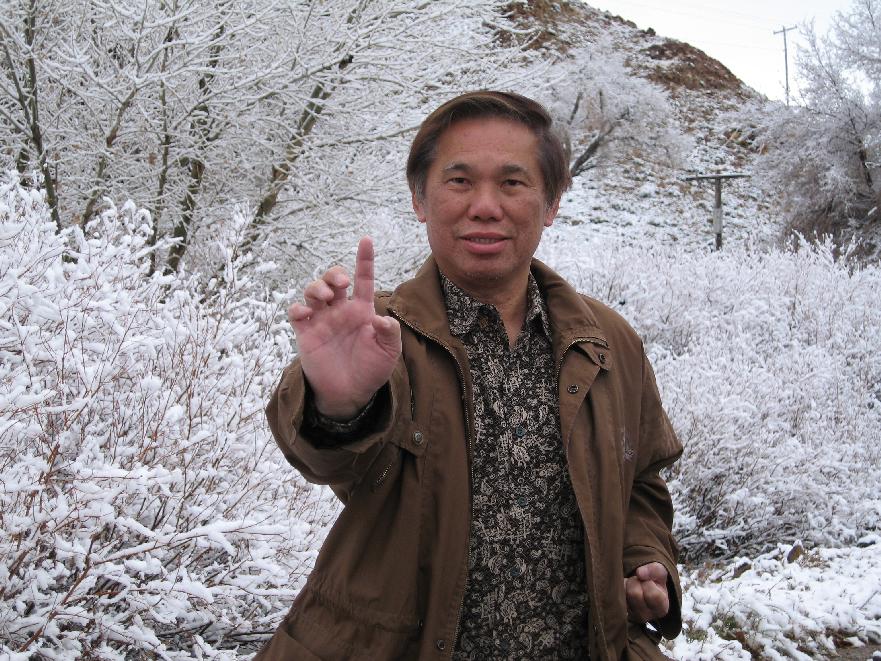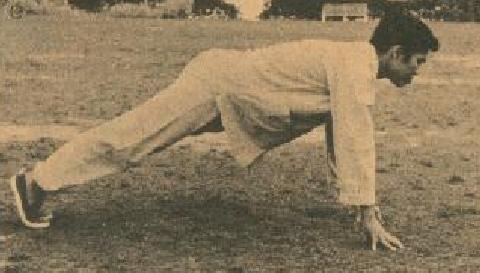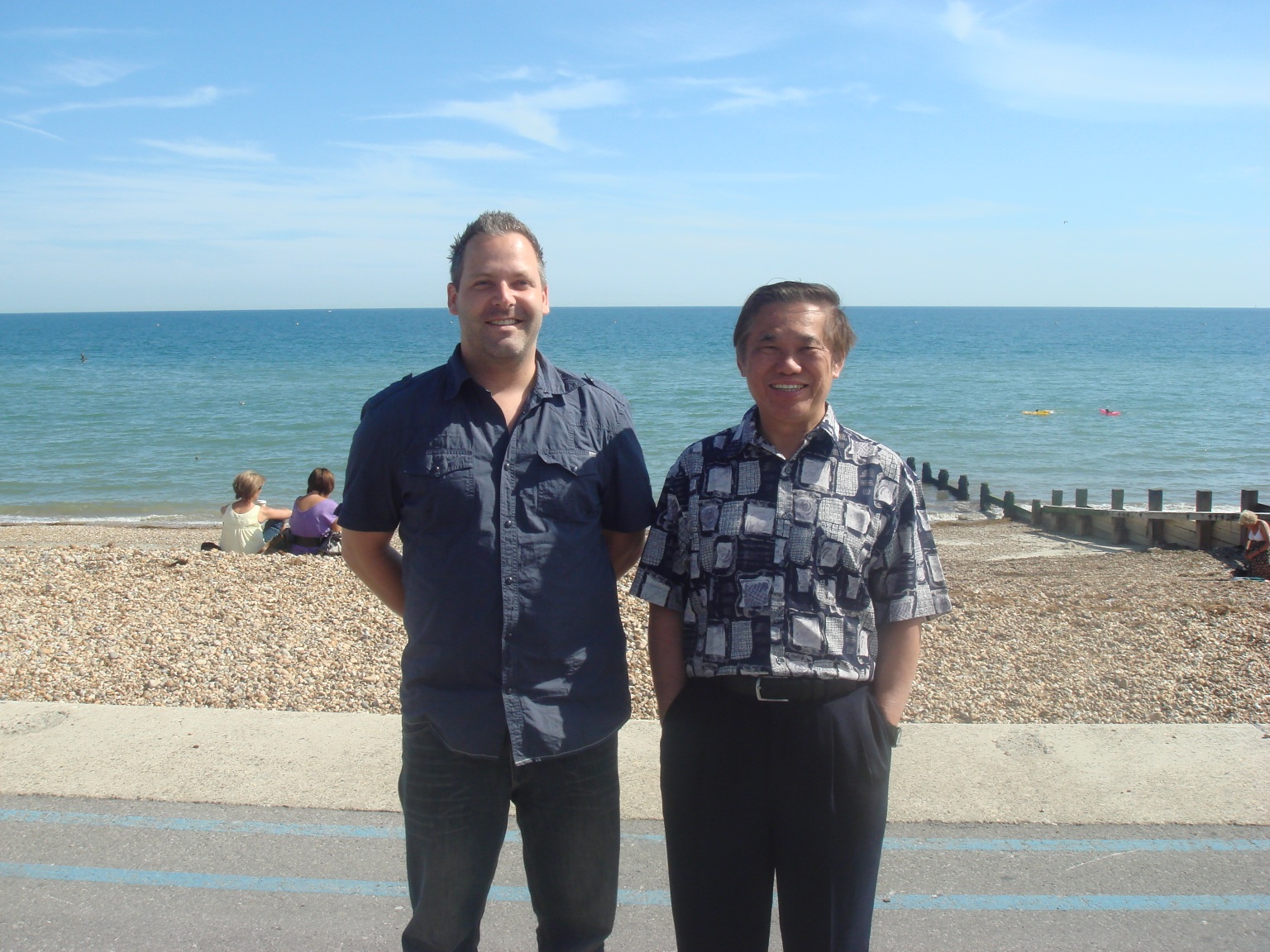INTERNAL FORCE VERSUS EXTERNAL FORCE TRAINING

One-Finger Shooting Zen, a principal internal training method in our school
Question 10
In my experience sparring with other martial artists, I have come across several exponents who are very fast and powerful, with near-instant reflexes and adaptability. Apart from the fact that they are naturally gifted with such athletic abilities, they have told me that their speed and power are developed through what we would call external training methods.
As Sifu has mentioned before, someone learning a more complex art like Taijiquan or high level Shaolinquan would take longer to reach a high level of combat efficiency compared to an art with less techniques. The same principle seems to apply to the training of force as well -- a martial artist using external methods can attain quite a high level of power, even if he may be overtaken in the long run by someone training internal force methods.
Following from the paragraphs above, I have two questions, related to each other:
(1) For a Shaolin exponent who primarily trains using internal training methods, how substantial should his internal force have to be before it is comparable to that of a competent and diligent external martial artist?
(2) An external martial artist who seeks to increase his strength and power would use progressions such as using heavier and heavier weights, spending more time or repetitions, or training more frequently.
How would an internal martial artist like Wong Fei Hong progress if he wants to increase his internal force or be able to apply his internal force in more ways, such as improving his speed and reflexes?
Sifu Zhang Wuji
Answer
We have no doubt of and respect for the ability of those who use external training methods. Personally I have more respect for their dedication to their arts than for those who have the opportunity to excel in internal training but do not train as dedicatedly.
Nevertheless, we also realize the limitations of external training. I can speak from experience as I have used both external methods and internal methods. The external methods I used, fortunately, were not the rough and tough methods used by many external martial artists today which left the trained parts of their body deformed or injured because I used medication in my external training.
The external martial artists may be fast and powerful, and have near-instant reflexes and adaptability, but it is doubtful if they can attain abilities of internal martial artists like catching arrows shot at them, deflecting attacks even when blind-folded, or running up four storeys in less than 8 seconds without panting.
Some people may not believe that internal kungfu masters could catch arrows shot at them, but there is no doubt internal martial artists can deflect attacks even when blink-folded or run up four storyes in less than 8 seconds without panting. Students at the Special Wing Choon Course in Penang in 2010 and I many years ago did that respectively.
Generally it takes a longer time to train internal arts than external arts. This is the traditional, and current, perspective of masters. An internal martial artist training Cosmos Palm, for example, would take a year to attain similar force that an external martial artist training Iron Palm would take 6 months to break a brick.
However, the force of an internal martial artist would last longer than that of an external martial artist. For example, presuming that both the Cosmos Palm exponent and the Iron Palm exponent stop training after successfully breaking a brick, the Cosmos Palm exponent can still break a break after six months without training whereas the Iron Palm exponent can do so only for a month or two.
There are many other benefits internal martial artists enjoy that external martial artists do not. A Cosmos Palm exponent, for example, is not only powerful at his palms but all over his body, whereas an Iron Palm exponent is only powerful at his palms. The force of Cosmos Palm can also be used to heal, whereas that of Iron Palm is only to destroy.
More significantly, internal force training contributes to good health, vitality and longevity, but external force training does not. An internal martial artist, for example, would have more stamina and mental clarity as a result of his training, but an external martial artist does not. Moreover, internal force is not limited to age, size and gender, but external force is. A slender woman of 60 with internal force, for example, can beat a bulky young man of 30.
The chance to train internal force is rare. Many masters have spent years chasing at internal force but to no avail. Our school is a ridiculous exception.
In my many years of teaching, I have made some amazing discoveries that may revolutionize internal force training. It is traditionally accepted that internal force training takes a longer time than external force training. But I have found that many of our students using internal training have developed force that surpasses external martial artists who have trained in a similar or even longer period of time!
My own examples illustrate the journey of these exciting discoveries. When I trained in Uncle Righteousness’ school, I hit a wooden men every night for a year, and applied medicated vinegar to strengthen my arms. My arms were powerful – compared to most people.
But when I learned Wuzuquan in Sifu Chee Kim Thong’s school, which was famous for internal force, my arms were literally nothing compared to the arms of my seniors. I had no idea how long they had trained, but I was sure it might be more than three years, or perhaps ten. This experience confirmed not only that internal force was superior but also it took more time to develop.
When I learned in Sifu Ho Fatt Nam’s school, I trained One-finger Shooting Zen. After a few months I could break a brick, which I could not do training Iron Palm for two years. This experience could not confirm that I took less time training internal force in One-Finger Shooting Zen than external force in Iron Palm because my external force of Iron Palm could have been carried over to my One-Finger Shooting Zen training.
However, the confirmation was quite clear when I knocked arms with a Shaolin master who trained external force dedicatedly. This external Shaolin master tried to impress me by hitting his Iron Arm at a pillar which supported a car porch in from of his house, and the porch literally shook. Finding that I was not impressed by his show of force, he asked me to knock arms with him in “Hitting Three Stars”.
He could only last two hits. When I gently swung my arm down for the third hit, he had already moved away. My internal force bounced him off. The harder he hit at me, the worse would be the bouncing off. I did not know for how long he had trained externally for his Iron Arm. I guessed it could be ten or more years. I had about three years of internal force training, and even when I added my two previous years of Iron Palm training, the total would only be five years.

The art of Taming-Tiger, an external method Grandmaster Wong practiced in his younger days
Another telling but unexpected experience was from an Aikido student who learned from me. He wanted to increase the force of his grip, so I taught him One-Finger Shooting Zen, which included Tiger Claw training. He reported to me that after about six months of daily training, he visited a kungfu school well known for internal force. He told me that he was very surprised at first that he could last about 30 hits knocking arms with practitioners of the school. Before learning from me, he also knocked arms with the master, but he could not last five hits. What was even more surprising was that the master, not him, who eventually gave way. The master must have trained his internal force for more than ten years.
Internal force was involved in both persons in this case. But it showed that our training of internal force was so effective that after only six months of training the internal force of this Aikido student surpassed that of the master who had trained for many years. And I taught this student at a time when my teaching methodology was far below that of today.
With hindsight I would conclude that our internal force training is so incredibly effective because of chi flow. We have chi flow right at the start of our internal force training, and we know the philosophy as well as have the techniques and skills of flowing force and consolidating force. Past masters did not know the philosophy. Their chi flow as well as flowing force and consolidating force occurred haphazardly, even when they trained everyday. Thus they took a much longer time to develop their internal force.
The concept becomes clear when we use some quantification. Suppose our students develop 100 units of internal force for each successful session a day. Training every day, and presuming the progress is uniform, our students would develop 3000 units of internal force a month.
When past master trained internal force as students, they were less effective and would not develop 100 units of force per successful session as they did not know that chi flow was necessary to develop flowing force and consolidated force. For them chi flow occurred incidentally when they attained an ideal condition without conscious knowing, not purposely like in our case. Suppose they obtained 50 units of internal force when such occasions occurred, which is a generous estimate for them.
But they would not have a successful session every day like our students. Suppose a successful session where conditions incidentally became ideal occurred six times a month, which is a reasonable estimate. But they would not have developed 50 x 6 or 300 units of internal force, because the days were too far apart for their internal force to be accumulated even when they practiced everyday. In other words, having obtained 50 units of force in one session, by the time they attained internal force in the next successful session, which was five days away, much of the original 50 units would have dissipated.
Let us be generous and estimate that only half of the force had dissipated, leaving them 150 units of force a month, or 1800 units of force a year. It would take them more than a year and a half to accumulate 3000 units of force, which our students can accumulate in one month!
On top of this, students in the past did not get to learn internal force in their early years of training. Only a very few of them who had spent at least ten years in the school and had won the trust of the master before they could have an opportunity to train internal force. Again, let us be generous and presume a dedicated, talented student had won the trust of the master in just five years, and took ten years to develop sufficient internal force to become a master himself, taking 15 years altogether, which actually was an exceptionally short time to become a master. But a dedicated student in our school today will take only one year to attain a similar level. This is unbelievable but true.
The standard of martial art today is lower than that in the past. If we assume that a competent and diligent external martial artist today has a level of force, even externally trained, comparable to the internal force of a talented and dedicated master in the past, a Shaolin student in our school today will need a year of dedicated daily training using internal methods to acquire a similar amount of force.
It is important to note that this student must train daily, not just learn the internal force training methods in a course and expect to have substantial force a year later without training. If he trains about an hour a day for a year, he would have substantial force to break a brick easily, and perhaps to break the bottom of two bricks without breaking the one on top. As the skull of an external martial artist is unlikely to be harder than a brick, and his internal organs even weaker, a strike by our student on the head of the external martial artist would break the latter’s skull, and a strike on his body would injure his internal organs without leaving external marks.
An internal martial artist like Wong Fei Hoong would increase his internal force by training longer or by adding weights in his training, like wearing copper rings on his arms when training Iron Wire.
But for us in Shaolin Wahnam, there is no necessity to train longer or add weights in our training, because our methods and skills are already very effective. Indeed we remind ourselves and ask our students to slow down our training so as not to over-train.
An internal martial artist needs not seek other methods to apply his internal force in more ways, like improving his speed or reflexes. Unlike external strength, which is limited in its specific function, internal force is alive.
Besides maintaining his life more harmoniously, an increase of internal force will automatically enhance his life, including enhancing his reflexes, and enable him to have better results no matter what he does, including increasing his speed. In other words, not only he does not need to practice other methods to apply his internal force in more ways, including to improve his speed and reflexes, he also does not need to learn how to channel his internal force for these more ways. As an analogy, if you increase your cash flow, there is no need for you to learn new methods to be able to buy more things. The increase of cash flow will automatically enable you to buy more things.
As a confirmation, there were no records of how Wong Fei Hoong or any past master trained to increase his speed and reflexes or any other abilities. Wong Fei Hoong, for example, did not ask his students to attack him systematically faster and faster so that he could train his speed and reflexes. As his internal force increases, his speed and reflexes also increased automatically.
In our case, for example, an increase of our internal force automatically increases our mental clarity and vitality, and enables us to do our work better in shorter time. We do not need to take extra lessons on mental clarity or take extra nourishment to increase our vitality. We do not need to learn new working techniques or purchase new machines to do our work better in shorter time.

Internal training enriches our daily life, but external training doesn't
The questions and answers are reproduced from the thread Legacy of Wong Fei Hung Q-A Series by Sifu in the Shaolin Wahnam Discussion Forum.
LINKS
